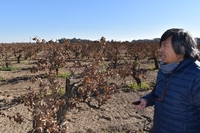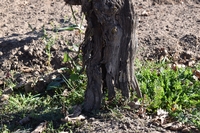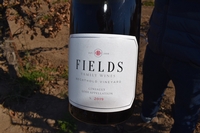It’s been just about a full year since we went into lockdown due to the COVID-19 pandemic, and that year has gotten me to feeling a little older than I think it should. Less physical activity combined with a full wine cellar does have a tendency to lead to first world problems like an expanding waistline and a general feeling that time is passing without any adventure factor to mitigate the piling up of days. After a zoom meeting focused on historic vineyards in Lodi, a small town not far south of Sacramento in California’s San Joaquin Valley, I decided to journey away from my comfy San Diego cage for a closer examination of a vineyard whose wines put a spark in my step.
I grabbed my wife and a couple of trusty traveling companions from my quarantine pod and headed north up the I-5 to meet up, in socially distanced

fashion, with wine and food industry veteran and Lodi guru Randy Caparoso for what would turn out to be one of the most informative tasting experiences I’ve ever had. Our first stop was a visit to Lodi’s oldest continuously farmed vineyard – the Bechthold Vineyard in Lodi’s westside Mokelumne River sub-AVA. The vineyard had first come to my attention thanks to a bottle of 2012 “Cinsaut” made by Onesta Winery’s Jillian Johnson; this review from 2015 will set the stage:
Onesta, Lodi (California) Bechthold Vineyard Cinsaut 2012 ($29): I've not seen this "L"-less spelling of the grape name before, but I suppose it doesn't matter since the pronunciation of the name never quite makes it to the final consonants anyway. Randall Grahm recently proclaimed that "San-sou" will be the next "big thing" in wine, and while I suspect that acres planted might be a significant barrier to such a thing happening any time soon, this offering from Onesta owner/winemaker Jillian Johnson is pretty delicious. Cinsault is usually used as a blender to add aroma and softness to other Rhone varieties, but here it solos to great effect, showing cherry, powder, rhubarb and spice in a medium weight package that finishes with ripe blackberry and cedar spice notes. A soft texture and bright acidity help make this very interesting -- imagine a cross of a bold Pinot Noir and a light styled Zinfandel and you'll get a glimpse of where this wine is coming from.
91 Rich Cook,
Wine Review Online, Nov. 17, 2015
We popped out for a stroll among the dry-farmed vineyard planted back in 1886 – vines that have survived two world wars, countless severe weather events, benign neglect, mis-identification and who knows what else. Vines whose roots can reach fifty or sixty feet below the powdery sandy loam surface in search of sustaining water. Vines that in some cases are hanging

on by threads of cell structure that you can see with close examination. We didn’t get too close though – a careless bump could easily destroy an entire vine.
Vineyards of this age are quite rare in California, or anywhere for that matter for myriad reasons – disease, socio-economics, etc. The state’s celebrated “old vine” Zinfandel vineyards get most of the attention – the original Grandpere Vineyard in Amador County is the oldest recognized still producing site, dating back to the 1860’s. Bechthold was first planted in by Joseph Spenker, and Al Bechthold farmed it from the 1970’s until 2008, when Michael & David winery took over the lease. A chance 2003 meeting between a UC Davis’ Viticulture & Enology Department worker and Al’s wife Wanda Woock Bechthold (who still lives on the property) led to the identification of the vines as being Cinsault, which led to interest from producer “Rhône Ranger” Randall Grahm’s Bonny Doon, which was quickly followed on by local producers.
All of which brings us to the present – a time when many producers clamor for a share of the fruit from this rarest of sites, and for good reason, as you’ll discover in my notes below. There’s a pulsing freshness in the wines that belies the place and the time that they come from, and there’s a common thread in the winemaking among the different producers that shows true respect for the source. If any or all of this sounds intriguing to you, I’d encourage you to support the cause with your wallet. It’s only through such support that sites like the Bechthold Vineyard have a chance to continue revealing their journeys on our tables. I know I’m feeling younger after the experience.
Let’s let the wine do the talking:
2018 Michael & David Ancient Vine Cinsault, Bechthold Vineyard, Lodi, California ($2)5: Here’s a gorgeous, delicious, easy to love red wine that contains a big piece of California history. The source vineyard (located in Lodi’s Mokelumne River sub-AVA, the largest of the 7 sub-AVA’s) was planted in 1886. It’s generally in the southwestern portion of the Lodi AVA, planted in the region’s “Tokay series sandy loam” soil type, which provides great drainage for grapevines in the near sea level flat vineyard. The fruit is highly sought after, and Michael and David’s take is a fresh, fruit forward wine that’s long on cherry and blueberry fruit and fall spice. It’s quite similar in style to Cru Beaujolais. I will say that I always have open wine around the house due to the nature of the job, and a lot of it gets passed off or down the drain. Not this one – it got the argon treatment, and it got completely consumed over the course of a week. Pair it with cheese and charcuterie, or meats from poultry to beef.
93 Points
2019 Jessie’s Grove Winery “SinSo,” Bechthold Vineyard, Lodi California ($25): Jessie’s Grove is best known for their historic “Royal Tee” vineyard of Zinfandel in Lodi’s Mokelumne River sub-AVA, but this wine, which is sourced from an equally historic site just to the south of the winery. Labeled in a way that novices can pronounce the grape name, it shows off what old vines can do. Intense aromas of cherry and raspberry are lifted by a dash of vanilla spice, and they get direct translation on a smoothly textured palate that draws out through a long, zesty finish. Drinking much Lodi wine that’s under 13% alcohol? Here’s a winner that’ll show you a different facet of the region. SinSo? I think so!
93
2019 ESTATEcrush Cinsaut, Bechthold Vineyard, Lodi California ($26): This expression of Lodi’s oldest continuously farmed vineyard show ripe pomegranate, blueberry and well folded oak toast in both aroma and flavor profiles, with a ripeness level that keeps everything lively from start to finish. A touch of brown spice comes forward after the liquid is gone, keeping the impression of the wine alive and intriguing. Serve this where you’d normally reach for Pinot Noir, but want a more zesty, fruit driven style.
92
2016 McCay Cellars Cinsault, Bechthold Vineyard, Lodi California ($40): It’s a treat to get to taste a wine from this amazing site with a few years under its belt. Give it a good decant to reawaken the freshness of the fruit, and enjoy the added depth that comes with a little aging. The prize is a mix of rich red fruit, earthy brown spice and racy acidity that linger long and satisfy deeply. It makes me want to stockpile vintages from the vineyard’s producers to enjoy for a long while.
93
2019 McCay Cellars Rosé of Cinsault, Bechthold Vineyard, Lodi California ($35): While not specified on the label, this wine is mainly sourced from a block of the Bechthold Vineyard that seems to lend itself well to Rosé. It’s long on cherry, raspberry and peach aromas and flavors, with notes of bay leaf and white pepper adding interest. It’s a find for fans of a rosé that comes with a little more body and weight than most dry examples.
90
2019 ESTATEcrush Rosé of Cinsaut, Bechthold Vineyard, Lodi California ($21): Here’s a subtle Rosé that’s long on refreshment, with juicy watermelon and strawberry fruit, well balanced acidity that keeps the mid palate weighty, and lively lime zest up in the finish that keeps it all fresh and inviting. It’ll go great with a tossed vegetable salad and an Herbs de Provence enhanced oil & vinegar dressing.
91
2019 Fields Family Wines Cinsault, Bechthold Vineyard, Lodi California ($26): Lots of consideration goes into how to best express the unique character of a vineyard. What level of ripeness, or sugar content at harvest,

is one of the larger points to consider, as it drastically affects the finished wine, especially when a minimal intervention approach is adopted. Winemaker Ryan Sherman opts for a barely and in my humble opinion perfectly ripe pick here, and the resulting wine shows a delicacy and elegance that an old (planted in 1886) vineyard can produce. The wine is quite floral on the nose, with notes of strawberry and cherry joining. On the palate, singing acidity helps translate aromas into flavors, and the finish adds an earthy character reminiscent of dried leaves and brown spice. If you’d like an alternative to the usual Pinot Noir on your fine dining table, this is a fine and wallet friendly choice. I love this wine!
94